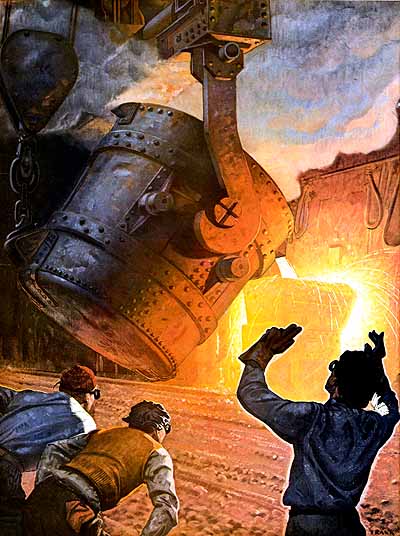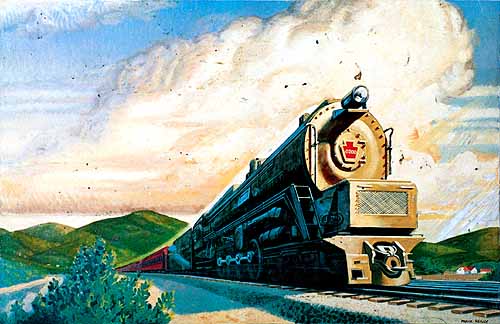
|
Copyrighted Material -CLICK for information |
|
Back |
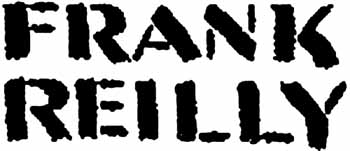 |
Frank Reilly
(1906 - 1967 )
Revolutionary Teacher |
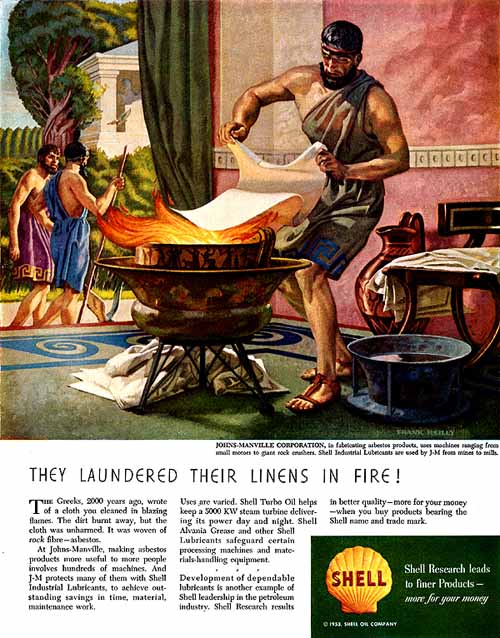
Shell, "They Laundered Their Linens in Fire!" (1953) Reilly - 001 |
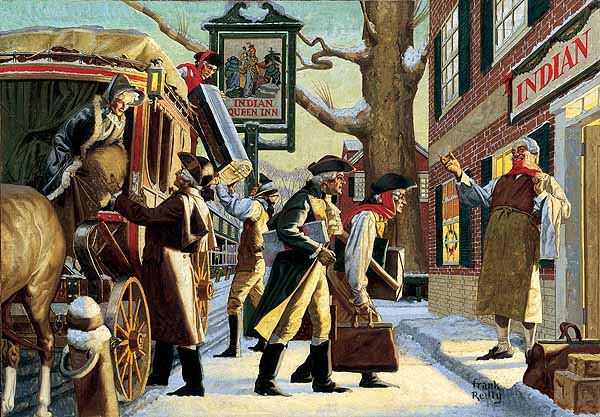
Philadelphia Blended Whiskey (1947) Reilly - 002 |
|
Painted for Philadelphia Blended Whiskey advertising campaign, this piece was one of a series of historical pictures of Philadelphia that Reilly created for Continental Distilling Corporation in 1947. Twelve paintings were produced for this series and released on lithographs as well as print ads.
|
| As the steady stream of students entering the large studio continued, the crowded room would begin to feel claustrophobic. Some opted to wait in the hallway just outside the door, hoping to get a private moment with their revered teacher before class would actually begin.
Then, seemingly larger than life, Frank Reilly would enter the room. As always, he would be dressed in a suit, white shirt and tie, projecting more the image of a Wall Street banker, than noted instructor at the historic Art Students League of New York. As successor to renowned anatomist George Bridgeman, Reilly taught: Drawing; Painting and Picture making; and Color abstraction. For 35 years, his classes at the “League” were always the most popular and highly attended. The waiting list to enter a Reilly course exceeded the number of students in attendance. In some instances these conditions would make it difficult to see the model posed at the head of the class. With so many students, Reilly would focus his greatest effort on the advanced or senior pupils, knowing that through sheer observation and osmosis his information would reach all of his students. Frank Reilly was a meticulous perfectionist. He approached art as a science, understanding that fundamental principles and formulas, when applied with consistency, were among the keys to becoming a successful artist. As a teacher, Reilly never touched brush to student canvas for demonstration, feeling the act was nothing more than a “teacher learning how to paint at the student’s expense.” This practice, and many of Reilly’s theories and innovations would be proven through the test of time. The list of great artists who were instructed and influenced by Reilly is monumental. It could be argued that no individual has contributed as much to Illustration and fine art, than Frank Reilly. |
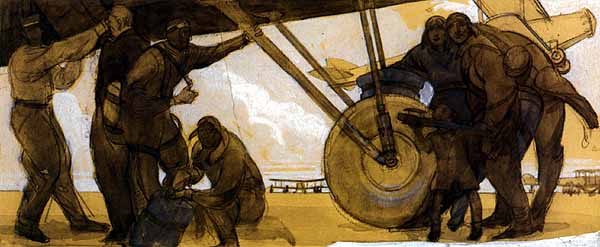
Study (late 1920s) Reilly - 003 |
| Formidable Roots By the time Reilly enrolled at The Art Students League, the Golden Age of American Illustration had come to an end. Many of the great artists of the 19th century had effectively retired, passed away, or simply hadn’t made the transition to the “modern era” of illustration art. However, there were those who had. In addition to producing editorial and advertising art, a number of these great artists passed along the knowledge and tradition of their craft through teaching. Artists such as Howard Pyle, Frank Vincent DuMond, and Harvey Dunn had been great teachers as well as artists. In the late 1800’s, Frank Vincent DuMond essentially brought the teachings of the French Academie to America and helped found the Art Students League of New York. He was instructed and influenced by Benjamin Constant, Boulanger, and Lefebvre in Paris and had become a highly successful illustrator upon his return to the United States. By the 1920’s the League had become renown for continuing the rich tradition of the Academie. Thomas Fogarty, Dean Cornwell, Robert Henri, George Bridgeman, as well as DuMond were among the Art Students League instructors during these years. Around 1935, a young Frank Reilly began lecturing at the Art Students League on the subject of creating an organized palette. With that, he embarked on a 35-year teaching career that would forever influence the way art was taught, produced, and viewed throughout the world. |
|
Pennsylvania Railroad (1946) Reilly - 004 |
|
The Artist As Illustrator Throughout the years Reilly accumulated an impressive list of clients who sought him out for the quality of his work and his impeccable professionalism. He painted covers for most of the leading magazines of the time in addition to story illustration. As an advertising illustrator, his work was highly regarded. As a testament to this, publications like The Saturday Evening Post, Colliers, Cosmopolitan, and Good Housekeeping, along with publishers such as Bantam, and Pocket Books (all clients of Reilly’s) would send their art directors to Reilly’s classes to present actual assignments to his students. In return, these various publishers, design studios, and advertising agencies had the “first look” at the best of Reilly’s protégés. Famed illustrator Dean Cornwell often used Reilly students to assist him in the production of various murals. Not only were these students among the best trained artists in the world, Frank Reilly instructed them on how to become responsible, professional businessmen. He told his students, “it is time to remove your painting smocks and don business suits.” This was unprecedented in the art world of the day. Reilly himself was greatly influenced by his favorite artists, Diego Velasquez, Pierre Puvis de Chavannes, John Singer Sargent, and J.C. Leyendecker. Several months after Hall of Fame illustrator Leyendecker passed away, Reilly was instrumental in rescuing a trunkful of the beloved artists works. He then brought the collection to the Art Students League for showing. The work was offered for sale to the students first, then to the public. This unwavering dedication and love for art as well as his love for his students is what made Frank Reilly unique. |
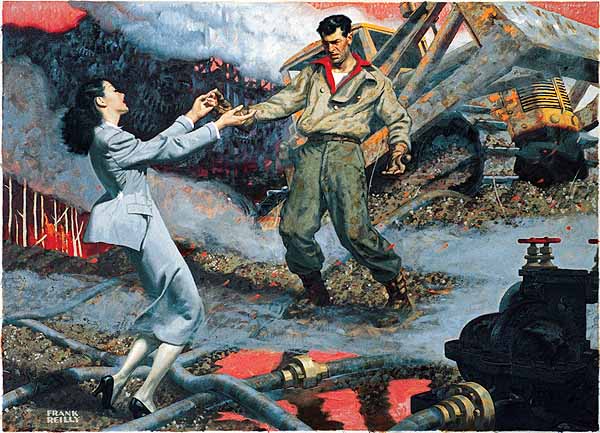
Skyline Red (1949) Reilly - 005 |
| Reilly painted this picture in 1949 for the Arthur Mayse story, "Skyline Red,' while at the height of his teaching and illustration career. |
|
Among Reilly’s favorite illustration assignments were: Pennsylvania Railroad, Continental Distilling Corporation, and Philadelphia Whiskey. In these, Reilly was able to employ extensive research in making an historically accurate picture. He often accepted work that other illustrators weren’t able to complete, as he did with friend and neighbor Dean Cornwell (Reilly and Cornwell lived in the same apartment building). Reilly also enjoyed the challenge and prestige of painting murals. He came from the school of Realists who had been rejected in the world of fine art in lieu of Impressionism and Abstraction. In designing and painting murals for the Bronx High School of Science in New York, the Johnson City Courthouse in Tennessee, and teaching mural painting at the National Academy of Design, Reilly had the freedom to explore all of his creative and technical abilities, including his fine art background. In addition to making pictures, teaching, and lecturing, Reilly wrote a weekly column for the Newhouse Syndicate titled, “Art for Your Sake,” was the Art Critic for the Art Colony of Woodstock (The Woodstock Townsman), and prepared four books for publication (Light and Shade; Figure Painting; Landscape Painting; Figure Drawing), though these were never produced. |
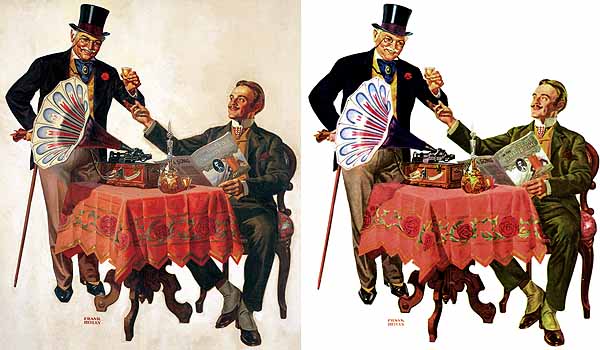
Kinsey Whiskey, original art at left and how the art appeared in print at right (1944) Reilly - 006 |
| This picture, produced for Lord Calvert Whiskey, is an excellent example of Reilly's ability to control his palette without sacrificing crisp brilliant color. The artist said that 80 percent of the picture depended on getting the values correct, 20 percent on correct chroma, and hue didn't matter much at all. |
|
It should be noted that after 40 years, internationally renowned illustrator, author, and teacher, Jack Faragasso, has written a book titled “Mastering Drawing: The Human Figure” based on Reilly’s teachings. Faragasso, himself a former student of Reilly’s, became Director of the Frank J. Reilly School of Art in 1967, and is regarded as the foremost authority on the Reilly System of painting and drawing. His book thoroughly presents the “Reilly Tradition” to a new generation of artists. Over the years, Reilly was awarded numerous honors and appointments for his exhaustive professional and civic efforts. Among them: membership in the National Academy of Design; National Society of Mural Painters; Allied Artists: Society of Illustrators; Century Association; Salmagundi Club; Inner- Society Color Council; Artists and Writers Guild; Dutch Treat; and the Optical Society of America. He also held the executive positions of, Vice-President of The National Society of Mural Painters; Vice-President of the Art Students League; Treasurer of the Society of Illustrators, and Department Head at the Moore Institute of Art. |
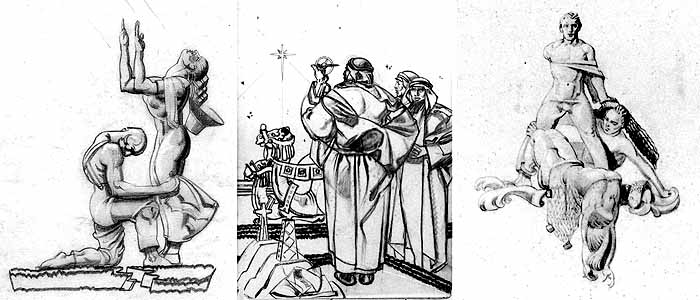
Mural Studies (19??) Reilly - 007 |
| These preliminary mural sketches show the influence of Greek sculpture in Reilly's work. He enjoyed drawing from life, and from African sculpture in particular, because it used stylized, simplified planes to define shape and form. Sketches like these would have been reworked numerous times before a master tracing was created and, in the case of a mural, assembled.. |
| Scholar, Innovator, Movie Producer? As an instructor, Frank Reilly taught 3 classes a day at the Art Students League, then drove to the Woodstock School of Art (a branch of the Art Students League, built by the CCC in the early 1930’s) to teach there. He presented 40 lectures a year, 26 of them at the Art Students League, the others at various art schools and institutes throughout the country. Subjects included color; painting the model; painting landscapes; anatomy; drawing and structure; perspective; drapery; composition; and abstraction in color and black and white. He also lectured on the history of art from the Masters to modern and illustration art. All lectures included examples and “drawings and paintings executed on the spot.” A former student noted, “Mr. Reilly could do a whole lecture on how to paint a bubble on a glass of beer.” Reilly also taught at the Grand Central School of Art with his former teacher Frank Vincent DuMond, Illustration at the Pratt Institute, The Moore Institute in Pennsylvania, The American School of Art in New York, and founded the Frank Reilly School of Art. This relentless dedication to teaching was the culmination of everything he had learned and observed throughout his years. |
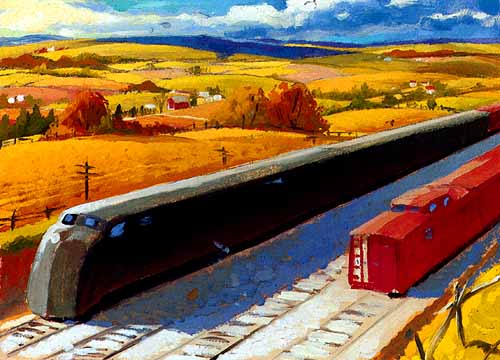
Train Preliminary (19??) Reilly - 008 |
| Reilly stressed that "nature cannot be copied, but must be simplified in order to work." This small preliminary study produced with eggshell tempera for a calendar illustration reads as clearly as a larger finished painting. |
|
Pennsylvania Railroad (19??) Reilly - 009 |
| One of the artist’s numerous advertising clients was the Pennsylvania Railroad. This image was created for a calendar. |
|
The Palette |
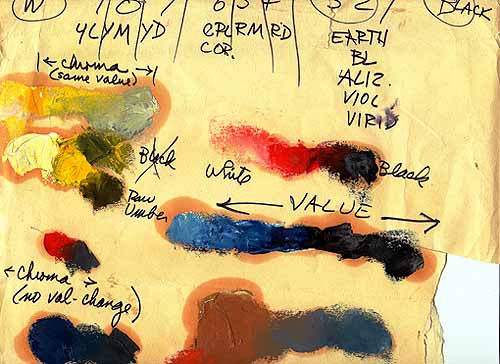
Reilly Palette (19??) Reilly - 010 |
|
This palette, consisting largely of fleshtones, was arranged by value rather than hue. It consisted of nine equidistant values of neutral gray mixed at the top of a glass palette. Below that row were 9 equidistant values of YR in the same order (cadmium orange out of the tube, being V7), reduced in value by adding burnt umber, white being added to create values 8 and 9. Below the YR came red in the same order (cadmium red light out of the tube, being V5). The final row showed the actual fleshtones used for painting. Again, they consisted of 9 equidistant values of the same hue. In this case, each hue was created by adding the same value red-orange-gray in various proportions depending on things such as complexion, light source, and time or type of day. If the subject was ruddy complected, more red could be added to the base mixture of the red-orange-gray. This base fleshtone is reduced in chroma and has the appearance of make-up or rouge. It is used in blocking in the mass shapes for a portrait or figure painting. Where purer color is required, as in a rosy cheek for a portrait or in the middle tones where it is more appropriate (high light and shade reduce color chromatically), one only needed to identify the correct value to be painted, then locate the desired hue and chroma on the palette. This was employing the Munsell system to it’s fullest potential. It gave artists more flexibility and control of their palettes and ultimately the quality of their work. Reilly produced numerous teaching aids, including hue, value, and chroma charts and formula graphs detailing how various colors reacted under various conditions. He charted every visible color in the spectrum and calculated how specific values of light and color shifted under every conceivable light situation. For example, white under normal daylight conditions appears as white. Under moonlight, however, white appears as a seventh-value gray. Reilly was teaching his students to be efficient as well as proficient. His approach to producing a sketch from life might go as follows. Locate the Spatial Relationships: “the big shape,” line 1 and 2, plumbing (horizontals and verticals), parallels, and negative shapes. Simplify with Rhythmical Relationships: long lines, rhythms, abstractions, and patterns of light and dark. Focus on Anatomical Relationships: drawing through, construction, the mannequin, and anatomy. He suggested drawing the “known” first, and working from the large to the small, from the simple to the complex. |
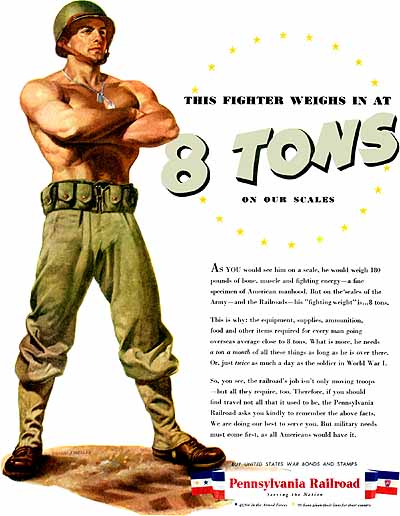
Pennsylvania Railroad, "This Fighter Weighs in at 8 Tons" (1944) Reilly - 011 |
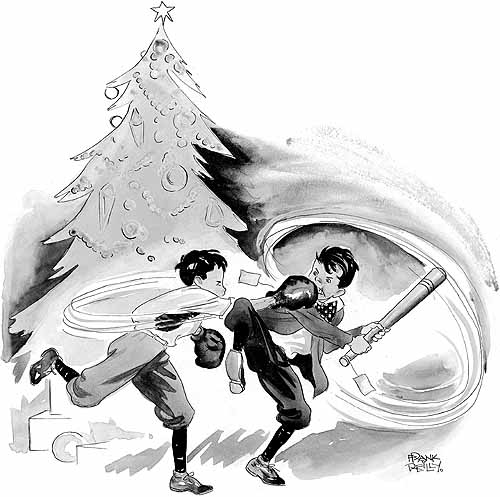
Judge Magazine (December 1930) Reilly - 012 |
| This gag cartoon appeared in the December 1930 issue of Judge magazine. It presents Reilly's sense of humor, as well as his willingness and ability to adapt to any medium. For this piece he used pen and ink with an ink wash. |
|
Illustration assignments that required painstaking research were approached through various working thumbnails and studies. Photographs of models and reference material was then shot. He began a “working drawing” from which black & white and color sketches would be created. The elements of composition and draughtsmanship were finalized with a master tracing. To recreate the spontaneity and tight composition of the thumbnails, Reilly then projected the master tracing onto a strung, but unstretched canvas, and drew the image onto the canvas with a sable brush and India ink. For a painting produced from life, he would “tone” the canvas with raw umber by dipping a rag into the paint and rubbing it into the canvas. This created an overall middle value that helped him locate and relate all of the values within his subject. |
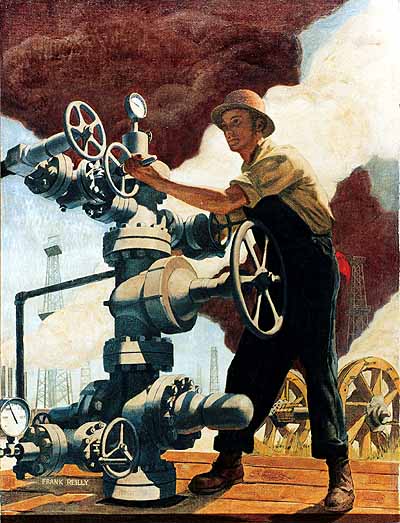
Oilfield (19??) Reilly - 013 |
| Reilly was called the working man's teacher and artist. Among his favorite subjects were scenes from industry, labor, and history. |
|
At this point in either approach, the procedure was similar. The initial masses and passages were applied thin with a mixture of paint and turpentine. Locating the darkest darks, he began to identify relationships of value. He occasionally used oil of cloves to keep the paint “wet” and cobalt dryer to accelerate the painting process, but generally didn’t recommend using mediums or additives. He painted with bristles, specifically flats for the beginning passages and full loads, then switched to sables for his finishing strokes. As the painting progressed, lighter values were located and fuller bodied brush loads of paint were applied. Actual finishing strokes and techniques may have varied from painting to painting. This procedure was likened to a wet on wet approach. The difference was that Reilly’s palette was in order and coordinated to his subject, whatever that may have been. Among Reilly’s numerous and generous accomplishments was the creation of the “Frank Reilly Grays”. Produced by Grumbacher until the 1960’s when they became too expensive to manufacture, these neutral grays were a commercial testament to the logic and success of “The Reilly System.” With these, the artist could be more organized and flexible in dealing with the various elements of consistently good picture making. Along with these grays, the Anjac Company produced Reilly Gesso Board. These innovations, along with others, were for making the creation of art more than just a hit or miss proposition. Reilly made virtually nothing from these efforts. Ideas and formulations that are a matter of routine for paint manufacturers of today were fundamentally tested, applied, and created by Frank Reilly over 60 years ago. |
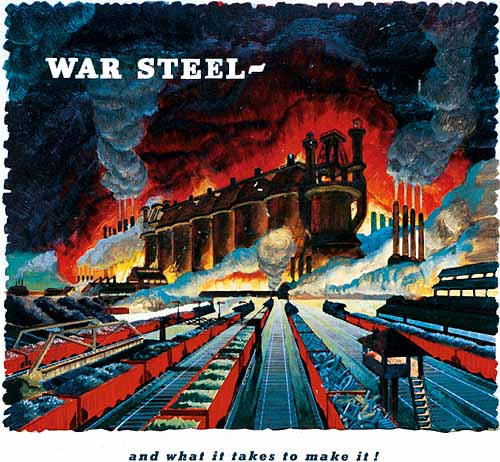
Pennsylvania Railroad, "War Steel - and what it takes to make it!" (c. 1944) Reilly - 014 |
|
This preliminary sketch was produced for Pennsylvania Railroad around 1944. The copy was pasted directly on top of the painting for a client presentation.
|
| The Consummate Artist Along with his impressive studies, art collection, vast library, and other resource and reference materials, Reilly was an expert photographer and cinematographer. Photography was part of his curriculum for picture making. The illustrator had to be familiar with cameras, lighting, and of course, posing the models for the creation of reference photos. Students were also instructed on darkroom and processing techniques. Reilly himself employed the use of reference photography, lighting and staging his reference photos with exacting detail. Reilly also made movies. These were16mm optical sound prints. To describe them as historic would be an understatement. In a resume dated May 1, 1954, he writes: “I have produced 14 motion pictures in full color and sound of other Artists. These films are made with my own equipment and have a definite place in the teaching of art. They are part of a program that will be a living history of Artists at work. In each film you hear the Artist’s ideas and principles, you see views of his studio, his palette, his model and his way of working. In each film you see the Artist start a painting and in stop-action you can follow each brush stroke to the completed canvas. This program is continually going ahead.” Among the Artists who participated in this remarkable stroke of genius were none other than Harvey Dunn, Dean Cornwell, James Montgomery Flagg, Arthur William Brown, Robert Brackman, John Sloan, John Falter, and William Oberhardt, to name a few. Frank Reilly’s boundless energy and dedication was sadly cut short in 1967 when he was diagnosed with a brain tumor and died shortly thereafter. Unfortunately, he didn’t live to fully see the ultimate success of his theories and principles. Expansive plans for the Frank Reilly School of Art were underway, with expectations of opening a west coast facility. A newspaper columnist wrote, “Frank Reilly is the number 1 art teacher in America.” His legacy will live on through all artists. |
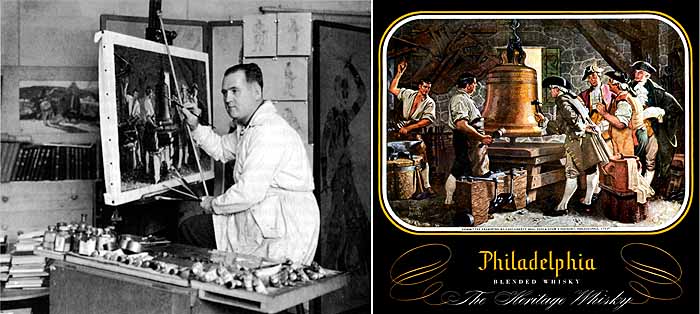
Reilly at work on Philadelphia Whiskey art (1944) Reilly - 015 |
|
Here the artist is at work on an illustration for the Continental Distilling Corporation’s historical renditions of the city of Philadelphia. The painting, as used in a 1947 advertisement, is shown at right. Committee Examining Re-Cast Liberty Bell, Pass a Stow's Foundry, Philadelphia, 1753. |
|
Kent Steine is an illustrator and writer based in Madison, Wisconsin. Many years ago, Steine had the fortunate pleasure of befriending Harry and Ruth Anderson.
Kent Steine has quickly become a friend of American Art Archives (and me, too). This respected artist's / author's contributions and experience on illustration art to American Art Archives will, I'm ecstatic to say, be ongoing! A "family tree" of Frank Reilly students (and their students in turn) will be appearing soon. For his biography and samples, please visit his website: KentSteine.com |
